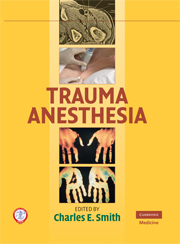Book contents
- Frontmatter
- Contents
- Foreword
- Foreword
- Preface
- Acknowledgments
- Contributors
- 1 Mechanisms and Demographics in Trauma
- 2 Trauma Airway Management
- 3 Shock Management
- 4 Establishing Vascular Access in the Trauma Patient
- 5 Monitoring the Trauma Patient
- 6 Fluid and Blood Therapy in Trauma
- 7 Massive Transfusion Protocols in Trauma Care
- 8 Blood Loss: Does It Change My Intravenous Anesthetic?
- 9 Pharmacology of Neuromuscular Blocking Agents and Their Reversal in Trauma Patients
- 10 Anesthesia Considerations for Abdominal Trauma
- 11 Head Trauma – Anesthesia Considerations and Management
- 12 Intensive Care Unit Management of Pediatric Brain Injury
- 13 Surgical Considerations for Spinal Cord Trauma
- 14 Anesthesia for Spinal Cord Trauma
- 15 Musculoskeletal Trauma
- 16 Anesthetic Considerations for Orthopedic Trauma
- 17 Cardiac and Great Vessel Trauma
- 18 Anesthesia Considerations for Cardiothoracic Trauma
- 19 Intraoperative One-Lung Ventilation for Trauma Anesthesia
- 20 Burn Injuries (Critical Care in Severe Burn Injury)
- 21 Anesthesia for Burns
- 22 Field Anesthesia and Military Injury
- 23 Eye Trauma and Anesthesia
- 24 Pediatric Trauma and Anesthesia
- 25 Trauma in the Elderly
- 26 Trauma in Pregnancy
- 27 Oral and Maxillofacial Trauma
- 28 Damage Control in Severe Trauma
- 29 Hypothermia in Trauma
- 30 ITACCS Management of Mechanical Ventilation in Critically Injured Patients
- 31 Trauma and Regional Anesthesia
- 32 Ultrasound Procedures in Trauma
- 33 Use of Echocardiography and Ultrasound in Trauma
- 34 Pharmacologic Management of Acute Pain in Trauma
- 35 Posttrauma Chronic Pain
- 36 Trauma Systems, Triage, and Transfer
- 37 Teams, Team Training, and the Role of Simulation in Trauma Training and Management
- Index
- Plate section
- References
25 - Trauma in the Elderly
Published online by Cambridge University Press: 18 January 2010
- Frontmatter
- Contents
- Foreword
- Foreword
- Preface
- Acknowledgments
- Contributors
- 1 Mechanisms and Demographics in Trauma
- 2 Trauma Airway Management
- 3 Shock Management
- 4 Establishing Vascular Access in the Trauma Patient
- 5 Monitoring the Trauma Patient
- 6 Fluid and Blood Therapy in Trauma
- 7 Massive Transfusion Protocols in Trauma Care
- 8 Blood Loss: Does It Change My Intravenous Anesthetic?
- 9 Pharmacology of Neuromuscular Blocking Agents and Their Reversal in Trauma Patients
- 10 Anesthesia Considerations for Abdominal Trauma
- 11 Head Trauma – Anesthesia Considerations and Management
- 12 Intensive Care Unit Management of Pediatric Brain Injury
- 13 Surgical Considerations for Spinal Cord Trauma
- 14 Anesthesia for Spinal Cord Trauma
- 15 Musculoskeletal Trauma
- 16 Anesthetic Considerations for Orthopedic Trauma
- 17 Cardiac and Great Vessel Trauma
- 18 Anesthesia Considerations for Cardiothoracic Trauma
- 19 Intraoperative One-Lung Ventilation for Trauma Anesthesia
- 20 Burn Injuries (Critical Care in Severe Burn Injury)
- 21 Anesthesia for Burns
- 22 Field Anesthesia and Military Injury
- 23 Eye Trauma and Anesthesia
- 24 Pediatric Trauma and Anesthesia
- 25 Trauma in the Elderly
- 26 Trauma in Pregnancy
- 27 Oral and Maxillofacial Trauma
- 28 Damage Control in Severe Trauma
- 29 Hypothermia in Trauma
- 30 ITACCS Management of Mechanical Ventilation in Critically Injured Patients
- 31 Trauma and Regional Anesthesia
- 32 Ultrasound Procedures in Trauma
- 33 Use of Echocardiography and Ultrasound in Trauma
- 34 Pharmacologic Management of Acute Pain in Trauma
- 35 Posttrauma Chronic Pain
- 36 Trauma Systems, Triage, and Transfer
- 37 Teams, Team Training, and the Role of Simulation in Trauma Training and Management
- Index
- Plate section
- References
Summary
Objectives
Understand the basic physiology of aging.
Utilize current concepts of elderly trauma outcomes to support triage decisions.
Apply knowledge of those aspects of aging required to design and execute an anesthetic plan for an elderly trauma victim.
When an elderly patient enters the trauma room, what is your first thought? Do you rush to be more aggressive because elderly patients are more fragile and need more immediate and intensive trauma care? Do you question whether the resources and effort necessary to treat such a patient are likely to provide benefit to the patient or society because the functional outcome for such patients is so poor? This chapter seeks to summarize the current knowledge regarding the best approach to elderly trauma victims.
Life expectancy in the United States continues to rise. Persons reaching the age of 65 years have an average life expectancy of an additional 18.1 years (19.4 years for females and 16 years for males) [1]. The retiring baby boomer population is more active than previous generations of elderly, many driving into their 90s and pursuing a variety of activities that increase their exposure to traumatic injury. Unintentional injury is the sixth leading cause of death among patients 65–74 years of age. This and other information can be accessed from the Web-based Injury Statistics Query and Reporting System supported by the Centers for Disease Control and Prevention (http://www.cdc.gov/ncipc/wisqars/)
- Type
- Chapter
- Information
- Trauma Anesthesia , pp. 391 - 401Publisher: Cambridge University PressPrint publication year: 2008



